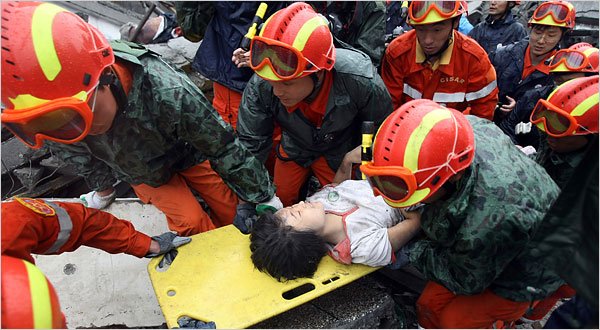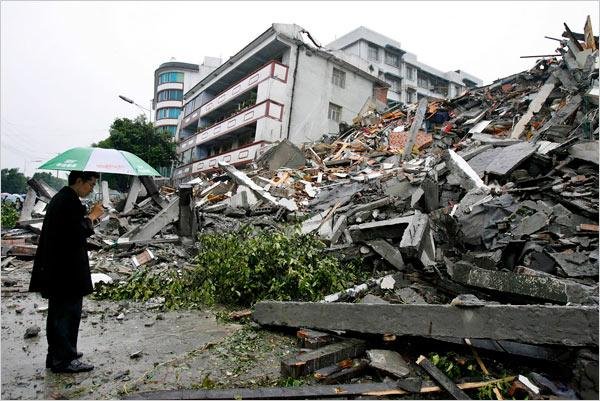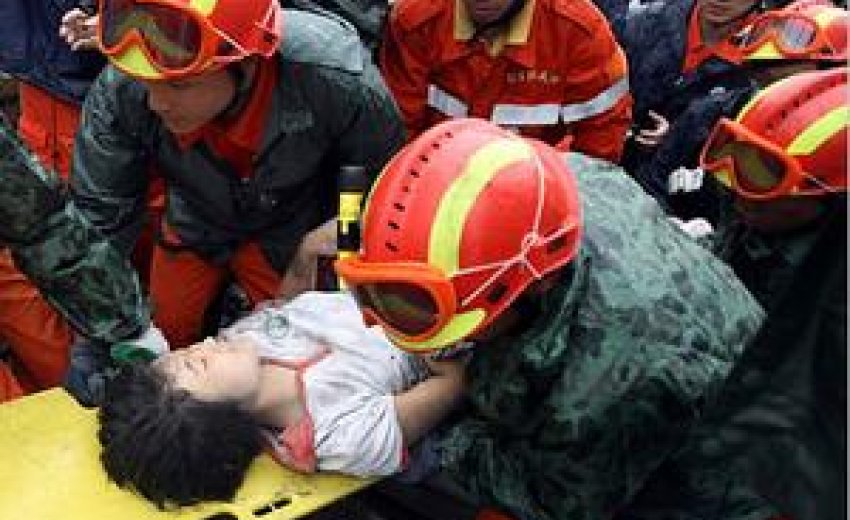BEIJING - Tens of thousands of people across southwest China remained buried beneath rubble on Tuesday as rescue workers struggled to reach areas cut off by a powerful earthquake that has left thousands dead and hundreds of thousands of others injured or homeless.
By late evening Tuesday, the official death toll had exceeded 12,000, according to state media, quoting provincial officials, making it China's deadliest natural disaster in three decades. Officials said they thought the death toll could still climb dramatically higher as workers broke through to the affected areas and the full scope of the disaster became clearer.
The authorities said that more than 18,000 people were still unaccounted for in Mianyang County in Sichuan Province and another 2,300 were missing in the collapse of a school and two factories in the nearby town of Shifang.
As a steady rain fell throughout the day, emergency workers struggled to pull survivors and bodies from flattened buildings in the few towns accessible to heavy rescue machinery. Nearly 2,000 of the dead included students and teachers killed when school buildings in the region crumbled.
More than 1,300 soldiers and medics spent the day clambering over landslides and the remnants of a mountain highway to reach Wenchuan, a city of 100,000 and the epicenter of the quake. The earthquake struck on Monday afternoon with a preliminary magnitude of 7.9.
Most victims were in the rugged center of Sichuan Province, although scores of deaths have been reported in five adjacent provinces. The official Xinhua news agency said that 37 tourists were killed when their bus was inundated by a rockslide, although it did not provide further details.
The authorities said 2,000 tourists were traveling throughout the region at the time of the quake, including 15 Britons and a group of 12 Americans on a panda-watching tour. A spokesman for the World Wildlife Fund, which sponsored the trip to the Wolong Nature Reserve, said they had yet to hear from the Americans, although he added they were in a rural area and presumed to be safe.
The earthquake on Monday shook buildings as far south as Thailand and set off another, smaller quake in the outskirts of Beijing, 900 miles away. The central government, which said it was spending $120 million on rescue efforts, has sent 50,000 soldiers to the disaster zone. Prime Minister Wen Jiabao flew to Sichuan hours after the earthquake struck, and has been shown personally directing the emergency effort.
News of the quake has dominated Chinese television coverage. The state-controlled media has been especially aggressive in its coverage, with reporters fanning out across the stricken region. Home video, cellphone images and commentary have been flowing uncensored onto Web sites.
In Chengdu, the capital of Sichuan, thousands of residents, rattled by more than 300 tremors, camped out in the streets. One aftershock on Tuesday afternoon registered a magnitude of 6.1. Most of the worst-hit areas remained without cellphone service. Officials said 13 tank cars containing gasoline on a derailed freight train in neighboring Gansu Province were still burning on Tuesday night.
The quake destroyed 80 percent of structures in some of the towns and small cities near its epicenter, Chinese officials said. The earthquake is China's biggest natural disaster since another one leveled the city of Tangshan in eastern China in 1976, leaving more than 240,000 people dead and posing a severe challenge to the governing Communist Party, which initially tried to cover up the catastrophe.
Monday's quake was the latest in a series of events that have disrupted China's planning for the Olympic Games in August, including widespread unrest among the country's ethnic Tibetan population, which lives in large numbers in the same part of Sichuan Province where the earthquake struck.
China's leaders often respond assertively to natural disasters, fearing a strong popular backlash if they bungle rescue efforts. But a complex relief operation on the scale that may be needed in Sichuan could strain Chinese resources even as the United Nations and many charitable groups are busy providing aid to Myanmar, which was hit by a huge cyclone this month. Chinese officials said they welcomed offers of foreign assistance, but it was unclear whether they would accept outside help.
Local leaders may also face intense scrutiny of their compliance with building codes. Since the Tangshan earthquake, China has required that new structures withstand major quakes. But the collapse of schools, hospitals and factories in several different areas around Sichuan may raise questions about how rigorously such codes have been enforced during China's recent, epic building boom.
The powerful initial quake struck at 2:28 p.m. near Wenchuan County, according to China's State Seismological Bureau. Most of the heavy damage appeared to be concentrated in nearby towns, which by Chinese standards are not heavily populated. Chengdu, the largest city in the area, with a population of about 4 million, is about 60 miles away and did not appear to have suffered major damage or heavy casualties.
-By ANDREW JACOBS
Dan Levin and Shi Yan contributed to this article.

